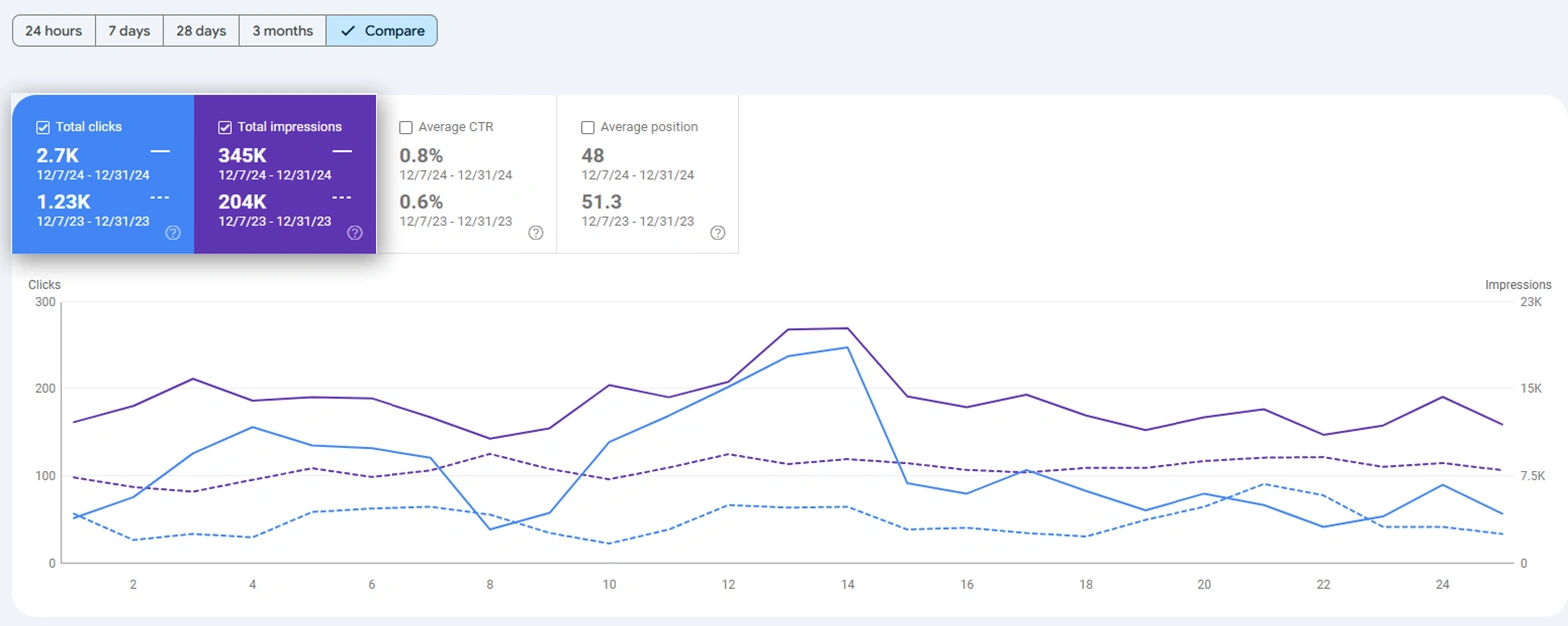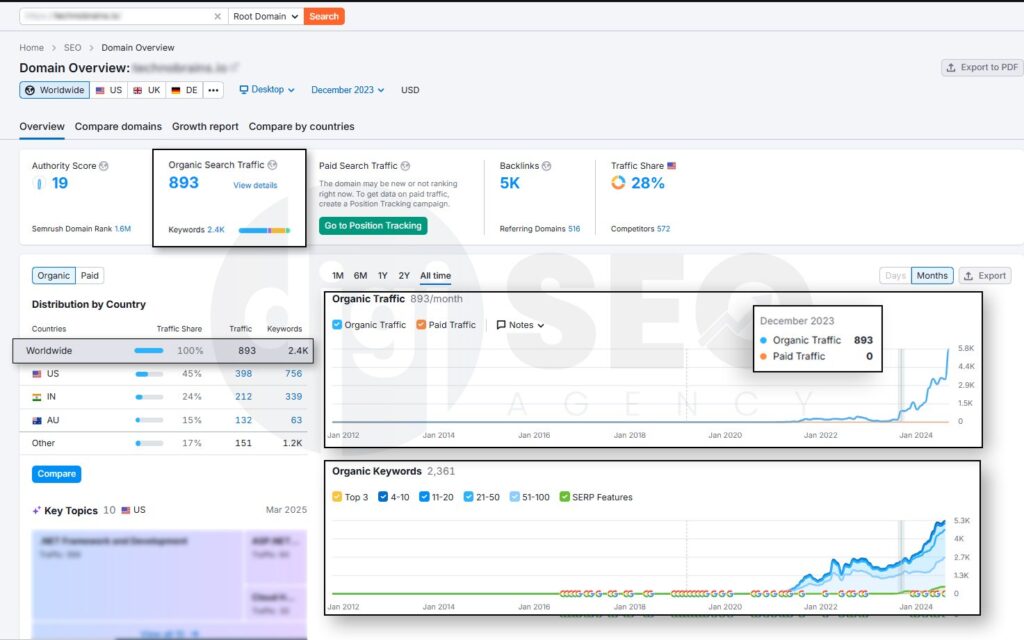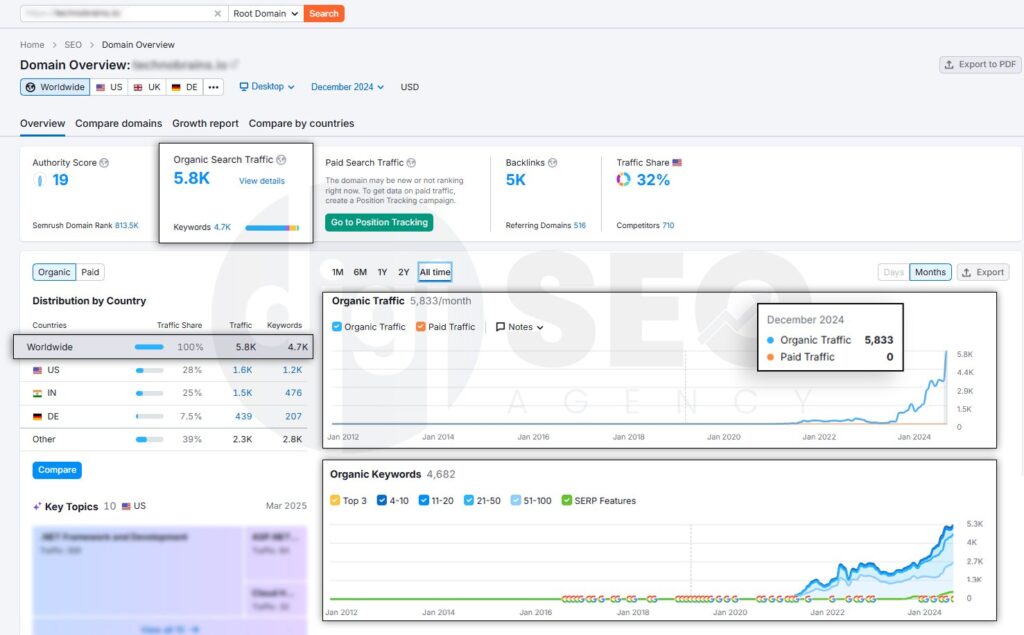
Project Overview
Client Profile
Primary Goal
The Challenges
Poor Search Visibility
The average position across all queries was 51.3 in December 2023. This meant that most of their content wasn’t even appearing on the first five pages of Google search results, rendering them virtually invisible to their target audience.
Low Organic Click-Through Rate (CTR)
The CTR in 2023 was a mere 0.6%, far below industry standards. Despite generating 204,000 impressions, the site only attracted 1.23K clicks. This indicated that either the content wasn’t resonating with users or the meta tags weren’t compelling enough to drive clicks.
Under-Optimized Content & Service Pages
Most of the service pages were not optimized with target keywords or structured to satisfy user intent. Several important long-tail and transactional queries were being overlooked.
Weak Technical SEO
Several technical issues hindered discoverability.
- No structured data/schema.
- Poor internal linking structure.
- Slow-loading mobile pages.
- Inconsistent use of canonical tags and metadata.
The Strategy We Implemented
Technical SEO Fixes
We began by addressing the foundation of SEO — the technical health of the website.
- Comprehensive audit: We ran a full technical SEO audit to find and fix crawl errors, broken links, indexation issues, and any performance slowdowns.
- XML sitemap updates: Cleaned up the sitemaps and ensured all key pages were listed properly so search engines could crawl and index them efficiently.
- Noindex fixes: Removed incorrect “noindex” tags that were unintentionally blocking important service pages from appearing in search results.
- Core Web Vitals optimization: Focused on improving mobile performance, page load times, and overall interactivity to align with Google's page experience metrics.
- Structured data integration: Added schema markup using JSON-LD for our services, blogs, and FAQs to enhance how pages appear in search, boosting eligibility for rich results.
On-Page Optimization
Once the technical groundwork was solid, we turned our attention to optimizing the actual content on the site.
- Revamped meta titles and descriptions: We rewrote them to be both keyword-rich and attention-grabbing, helping improve click-through rates.
- Improved headings (H1 to H3): Cleaned up the hierarchy and structure of headings on key pages to ensure clarity for both users and search engines.
- Strengthened internal linking: Connected related blog and service pages with relevant internal links to improve site navigation and crawlability.
- Added FAQs and intent-driven content: On each service page, we introduced FAQs and additional sections aligned with user search intent to keep visitors engaged longer.
Content Strategy Overhaul
A strong content plan was essential to compete with top-ranking sites in our niche.
- Keyword gap analysis: We analyzed what our competitors were ranking for that we weren’t, and built a plan to bridge that gap.
- Topic clustering: Grouped content around major services like custom software development, cloud solutions, and mobile app development to strengthen topical authority.
- In-depth service page rewrites: We didn’t just tweak a few words — we rewrote every service page with a clear goal: to align it with how users search today. This included:
- Keyword research: Uncovered what prospects are searching.
- Structuring content: Ensured scannability and clarity (think subheadings, bullet points, and visuals).
- Highlighting pain points, solutions, and benefits: Used a more compelling tone to engage the audience.
- Using semantic keywords: Incorporated them naturally to boost page relevance.
- Optimizing for mobile reading: Ensured tone and format were aligned with mobile users.
These rewrites helped each page stand out in search results and perform better in converting visitors.
Competitor Benchmarking & Keyword Strategy
Knowing what others in the space are doing helped us stay one step ahead.
- Analyzed top competitors: We took a close look at what kind of content was ranking well, which keywords they were targeting, and how they structured their pages.
- Built a focused keyword plan: From high-volume awareness-stage terms to conversion-ready bottom-of-funnel keywords, we prioritized based on intent, competition, and potential ROI.
- Created keyword-driven content silos: Designed content clusters that answered questions at every stage of the user journey — helping Google better understand our site structure and improving overall visibility.
The Results
Key Observations:
- The increase in clicks was almost 2.2X, indicating both improved visibility and more compelling listings.
- The 69% jump in impressions shows that we expanded keyword coverage significantly.
- A 33% rise in CTR means users found our titles and meta descriptions more relevant and appealing.
- The 3.3-position improvement in average ranking is crucial—moving even a few places up on Google can double or triple click potential.
A Notable Milestone
Additional SEO Milestones


Key Takeaways from the Case Study
SEO Takes Time but Yields Compounding Results
By focusing on high-impact areas such as technical SEO and intent-based content, we built momentum that showed tangible gains in under 12 months.
Meta Content Still Matters
Small improvements in titles and descriptions made a measurable difference in CTR. Emotional triggers like “Proven,” “Expert,” or “Tailored” drove more clicks from searchers.
Internal Linking Drives Indexation
Using contextual internal linking between blogs and service pages helped Google better understand the site architecture and index more URLs efficiently.
Rich Content Wins the Game
Blog posts optimized for long-tail keywords and formatted with questions, lists, and schema significantly improved engagement and visibility.
Technical SEO Is the Foundation
All the content in the world won’t matter if your website isn’t indexable, fast, or mobile-optimized. Fixing the fundamentals improved both the crawl rate and the bounce rate.
What’s Next? To build on this momentum, we’re now:
- Expanding the FAQ schema and how-to structured data.
- Launching localized landing pages for geo-specific keywords.
- Building a backlink profile through guest posting and digital PR.
- Introducing programmatic SEO for scaling content based on search patterns.

